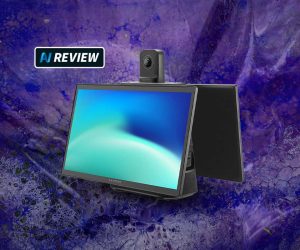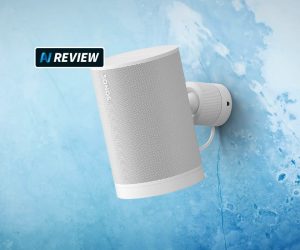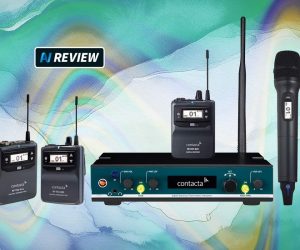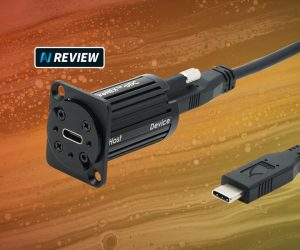
Review: Panasonic PT-DZ110XE
A punchy and compact 10.6k WUXGA 3 x DLP projector.
Review:/ Stuart Gregg
When this projector arrived, my initial thoughts were “I hope this unit performs”. The form factor, specifications, features, build quality and price all appeared to stack up, so I really hoped it would walk the talk.
The quick specification run down is, a 10,600 ANSI lumens, 3 x DLP WUXGA projector in a good size box, weighing in at a respectable 24kg, including lens. This makes it a punchy unit that is ideal for ballrooms and lecture theatres. The projector is just half the size of its predecessor, which is no mean achievement.
My only concern is that producing that much light in a much smaller case has ramifications for heat dissipation and cooling and consequently product life and reliability. That said, at one point we had the projector running for over eight hours and it never felt unduly hot to the touch. The exhaust vents seemed to push the hot air quietly and effectively away.
If the world of installation is more your thing then the claimed lamp life of 2500 hours at full power and auto-cleaning filter make it a low-maintenance unit. As with all claims about lamp life; in a review you can never verify or dismiss them, but from experience I use half the claimed hours as a rule of thumb. I’ve found with all the projectors I have owned that lamp changes are required at around that mark if you want the image to still have acceptable colours and/or brightness.
The other nice function aimed at installations, and one that I have not used before, is the easy-to-use built-in scheduling. This allows you not only to have the projector power on and off at set times of day, but also to switch input sources, swap lamp powers and open and close the shutter. This makes smaller digital signage applications easy and avoids the need for external control systems.
OUT OF BOX EXPERIENCE
Fitting the lens was simple and felt nicely secure. The lens range is comprehensive from a fixed 0.7:1 up to 13.8:1 with very few gaps in the range. Lens shift is 55% vertical and 20% horizontal.
We set the projector up on a 3m screen in semi blackout and fed it a range of test images from a live camera, a computer and a Blu-ray player. The menu system is clear and effective and the only criticism of it would be that it’s not aesthetically pleasing and looks lower tech than the unit deserves.
Without going into any of the features of the projector, the initial images were good and what you would expect to see from any of the top projector manufacturers. The projector had no issues detecting sources and auto image-setting for any resolution or colour space. As most projectors these days can achieve this, we decided to see how good we could get the projector to look by using the host of on-board image processing features.
First we looked at the Digital Clarity 3 processing, which according to the brochure uses sampled data from each scene to produce more natural and lifelike images. The brochure and marketing material use examples of high definition portraits and focuses on the quality of the reproduction of high detail areas such as hair and skin. We did the same, then tried out some high-resolution wildlife shots. The results were good, with the projected image reproducing detail in hair, fur and skin with lifelike detail and no unnatural sharpness.
Next we played dark scenes from our favourite movies to see how well the dynamic iris and claimed 10,000:1 ratio held up. Suffice it to say I would be happy to have this unit as a home cinema. The best result for general movie use was the intermediate setting. I have a personal preference to have the dynamic iris off for general graphics and presentation use.
MORE INFO
PRICE
RRP: $64,349 (including GST, but not including lens)
CONTACT
Panasonic: www.panasonic.com.au or 132 600

SEEING SOME DAYLIGHT
Most of our daily use for projectors at Haycom is for slide presentation in a range of lighting environments, so the System Daylight 2 was interesting to us. This technology claims to optimise image quality to improve colour perception of the projected image in bright rooms. The projector adjusts gamma curves, sharpness and colour correction to improve the quality of images in bright environments. We fed the projector a slide presentation with a light background and then turned the lights on to 80%. The projector did respond and produce a good image, but we lost some of the subtle detail in the background.
If medical imaging is of interest, the projector has a DICOM (Digital Imaging and Communications in Medicine) simulation mode. This imaging mode is similar to DICOM part 14, which is an imaging standard designed to give clarity to x-rays, CAT scans, PET scans, etc on large screens.
We then spent some time going through the other standard menu features such as colour temperature, sharpness, clock, phase and keystone, all of which were easy to use and did what was expected.
Some of the more interesting and advanced features of this projector that initially caught my attention are the built-in edge blending, colour and brightness matching, and geometry correction. The geometry correction has three areas, Keystone, Curved and PC. The Keystone gives good horizontal and vertical keystone as well as sub keystone, which allows you to adjust one corner only, producing asymmetric shapes. There is also linearity correction, which is a nice feature. The image resulting from the application of keystone correction is reasonable and not too jaggy.
The Curved menu allows for some preset curved distortions, allowing for convex and concave projections. Similar to sub keystone, you can adjust just one edge to create asymmetric distortion. We did not get to try the PC control, but in this mode a range of geometry corrections can be applied simultaneously.
The edge blending is available on all edges individually or in combination. It has comprehensive adjustments and should achieve good results. One minor downside is that edge blending does not perform correctly if you are on a curved surface and using the geometry correction.
MULTI-PROJECTOR CAPABILITIES
No surprisingly, with only a single projector to test we could only look through the menu and try some of the multi-projector features standalone.
Colour matching aims to correct for slight variations in the colour reproduction range of individual projectors and can be set in three-or seven-colour modes, by either manually entering figures, or using a colourimeter which should make multi-projector jobs easier.
The brightness matching feature is intended to allow projectors in an array to constantly monitor each other and adjust to keep their outputs matched and the image even. It’s possible to connect up to eight projectors via a hub, or up to 2048 via a PC and software (hmm, I would like to see that job).
The last chocolate on the pillow is the built-in waveform monitor. Using this function with a test disc or reference image you can adjust the projector to ensure you are getting the full range of the signal reproduced.
In summary, the projector is easy to use, well built and produces some good images. If the projector and lens price comes in as expected and it stands up to the test of time, then Panasonic is going to shift a good number of units. It’s no real surprise to see one of London’s well known and respected AV houses has added a fleet of them to their inventory.















RESPONSES